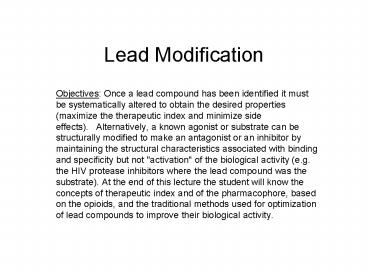Lead Modification - PowerPoint PPT Presentation
1 / 25
Title:
Lead Modification
Description:
Alternatively, a known agonist or substrate can be structurally modified to make ... antipruritic (anti-itch) activity. Ring-Chain Transformations. Isosteres ... – PowerPoint PPT presentation
Number of Views:500
Avg rating:3.0/5.0
Title: Lead Modification
1
Lead Modification
- Objectives Once a lead compound has been
identified it must be systematically altered to
obtain the desired properties (maximize the
therapeutic index and minimize side effects).
Alternatively, a known agonist or substrate can
be structurally modified to make an antagonist or
an inhibitor by maintaining the structural
characteristics associated with binding and
specificity but not "activation" of the
biological activity (e.g. the HIV protease
inhibitors where the lead compound was the
substrate). At the end of this lecture the
student will know the concepts of therapeutic
index and of the pharmacophore, based on the
opioids, and the traditional methods used for
optimization of lead compounds to improve their
biological activity.
2
Oral contraceptives are an example
3
Therapeutic index (therapeutic ratio)
- measure of the ratio of undesirable to desirable
drug effects (multiple bioassays) - in vivo LD50/EC50 therapeutic index LD50
the lethal dose for 50 of the test animals
EC50 the effective dose that produces the
maximum therapeutic effect in 50 of the test
animals - The larger the therapeutic index the greater the
safety of the drug goal of lead optimization
4
Pharmacophore
- Pharmacophore identification via functional group
modification - 1) systematically alter or remove portions of the
molecule - 2) identify regions essential for activity (or
different types of activities) - 3) note that pharmacological data is sometimes
ambiguous (i.e. data is not clear cut yes or no,
but often somewhere in between), requiring care
when interpreting relationships of structure to
activity.
5
Opioids as an example of a functional group
modification to identify a pharmacophore
6
Remove tetrahydrofuran ring and hydroxyl at R'
i) levorphanol ii) 3-4 times more potent as an
analgesic than morphine iii) maintains addictive
properties iv) therefore, tetrahydofuran ring
and R' hydroxyl not essential for activity
7
Removal of half of the cylcohexene ring
i) benzomorphan partial separation of analgesic
and addictive properties ii) cyclazocine and
pentazocine much lower addictive properties
iii) therefore, cyclohexene ring contributes to
the addictive properties
8
Removal of all fused rings
i) Demerol 10-12 potency of morphine ii)
therefore, final fused ring not essential for
analgesic activity
9
Acyclic analog
i) Darvon 1/2 to 2/3 as potent as codeine ii)
Methadone as potent an analgesic as morphine
less, but, still addictive iii) therefore,
conformation of the substituents, not the rings
themselves are important for activity
10
Structure of opioid pharmacophore
11
Increase rigidity and/or structural complexity
12
Functional group modification
13
Homologation
Relationship of potency to the number of
methylene group
14
Chain branching
15
Primary through quarternary amines
16
Chain branching (continued)
10-aminoalkylphenothiazine 1) -CH2CH(CH3)N(CH3)2
(promethazine) 2) -CH2CH2N(CH3)2 (diethazine)
for 1 and 2 antispasmodic and
antihistaminic 3) -CH2CH2CH2N(CH3)2 (promazine)
decreased antispasmodic and antihistaminic
activities has sedative and tranquilizing
activities 4) -CH2CH(CH3)CH2N(CH3)2
(trimeprazine) reduced tranquilizing
activity antipruritic (anti-itch) activity
17
Ring-Chain Transformations
18
Isosteres
- Functional groups with similar properties
(structural or chemical, such as hydrogen bonding
ability). - Often used to modify lead compound activity (i.e.
fine tune biological activity) in order to
minimize toxicity alter metabolism
maximize bioavailability
19
Classical isosteres
- i) groups that have the same number of valence
electrons but may have different numbers of atoms - ii) atoms, ions or molecules in which the
peripheral layers of electrons can be considered
identical
20
Examples of classical isosteres
- Univalent atoms and groups (note the same number
of total or valence electrons) Series A) CH3
NH2 OH F Cl Series B) Cl PH2 SH Series
C) Br i-Propyl Series D) I t-Butyl - Bivalent atoms and groups Series A) -CH2-
-NH- -O- -S- -Se- Series B) -COCH2R -CONHR
-CO2R -COSR - Trivalent atoms and groups Series A) -CH -N
Series B) -P -As - Tetravalent atoms Series A) C Si Series
B) C N() P() - Ring equivalents (e.g. these functional groups
are in the rings) Series A) -CHCH- -S- (eg.
benzene versus thiophene) Series B) -CH -N
(eg. benzene versus pyridine) Series C) -O-
-S- -CH2- -NH- (eg. tetrahydrofuran vs.
tetrahydrothiophene vs. cyclopentane vs.
pyrrolidine)
21
(Nonclassical) Bioisosteres
- Not included with classical isosteres
- Will contain at least one similar physical
property, although structures can differ
significantly - Properties considered in bioisosteressize shape
hydrophobicitypKa chemical reactivity
hydrogen bonding capacity
22
Examples of bioisosteres for the carbonyl and
carboxylate groups
23
Examples of bioisosteres for hydrogen, hydroxyl
groups, halogens, and a methylene spacer
24
Use of bioisosteres allows for testing the
biological role of functional groups
- Structural
- Receptor interactions
- Pharmacokinetics
- Metabolism
25
Comparison of 10-aminoalkylphenothiazine and the
-CH2CH2- analog































